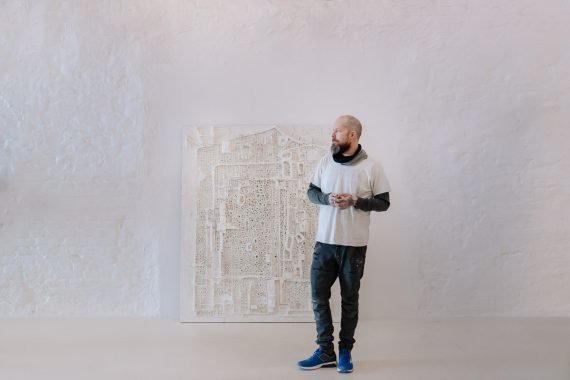![Mural Festival Highlights Deaf Artists and Honors the Deaf Community [Interview] Mural Festival Highlights Deaf Artists and Honors the Deaf Community [Interview]](https://winklersart.com/wp-content/uploads/2025/02/mural-festival-highlights-deaf-artists-and-honors-the-deaf-community-interview.jpg)
Mural Festival Highlights Deaf Artists and Honors the Deaf Community [Interview]

# **KissFist Mural Fest: A Celebration of Deaf Culture Through Public Art**
Murals have historically served as a lively means of storytelling, community, and artistic expression. Artist Kate Fitzpatrick, a muralist and child of deaf adults (CODA), has elevated this art form with the inception of the **KissFist Mural Fest**, an inclusive mural festival aimed at highlighting the vibrant and diverse culture of the deaf community.
Scheduled for October at **RiNo ArtPark in Denver, Colorado**, this pioneering festival intends to promote inclusion, eliminate barriers to access, and offer a **platform for deaf artists** to present their creativity.
In a candid conversation with *My Modern Met*, Fitzpatrick shared her motivations for the festival, the necessity for increased accessibility in public art events, and the role murals can play as impactful mediums for representation.
—
## **The Vision Behind KissFist Mural Fest**
Fitzpatrick’s vision for the festival stems from her personal experiences. Being part of the deaf community from birth, with both parents being deaf, she observed a **shortage of accessibility in numerous art venues**, a concern that became evident during a mural festival she attended. At an awards ceremony conducted in **spoken English** without an interpreter, her deaf family members found themselves excluded from accessing vital information about the event.
This incident inspired the concept of KissFist Mural Fest—a gathering where **deaf, deafblind, hard of hearing, and CODA artists** are not merely acknowledged but truly celebrated.
The festival’s title **”KissFist”** originates from **American Sign Language (ASL)**. Fitzpatrick elaborates that it symbolizes a gesture of deep love and appreciation, similar to expressing “I love this!” in English. The festival encapsulates this spirit, promoting joy, community, and cultural celebration.
—
## **Why Murals?**
Murals play a crucial role in public art, recognized for their accessibility and their capacity to **bring art to the masses**. In contrast to conventional **galleries and museums**, which can often feel daunting or hard to access, murals are present in everyday locations.
Fitzpatrick holds the belief that murals **humanize** urban landscapes:
> “Murals are large, messy to create, and they embody both flaws and beauty. When I look at a mural, I can discern the artist’s touch within it. In the era of AI, this authenticity is more significant than ever.”
Moreover, murals offer a **tangible and visible representation** for historically marginalized communities, making them ideal focal points for the festival.
—
## **Festival Highlights**
The **three-day festival** encourages artists and attendees to immerse themselves in muralism, deaf culture, and **live performances**. Notable features of KissFist Mural Fest encompass:
– **A minimum of 10 mural artists** crafting pieces on 4×8 foot panels. These panels will subsequently be auctioned off, with proceeds divided between the artists and the festival.
– **An art market showcasing Deaf Artisan Market Day**, highlighting the entrepreneurial endeavors of deaf artists and creators.
– **Visual Vernacular (VV)** performances, a unique storytelling mode developed in the deaf community that fuses **mime, poetry, and ASL** to produce a highly visual narrative.
– **Food and beverages**, ensuring the festival remains an inviting, family-friendly venue for enjoying art, culture, and community.
A fundamental principle of the festival is its **commitment to fairness**. Unlike many competitive art showcases, KissFist Mural Fest guarantees that **every artist receives equal compensation**, mitigating financial uncertainty for participants.
—
## **Breaking Barriers for Deaf Artists**
Traditionally, the deaf community has been **marginalized or underrepresented** in various creative realms due to a lack of accessibility. Audism—a form of discrimination against the deaf—has led to cultural obstacles, including **restricted job prospects, inadequate representation in media, and insufficient public support**.
KissFist Mural Fest actively addresses this challenge by **placing deaf culture at the forefront** in a manner that promotes connections rather than seclusion.
One widely recognized issue in the deaf community is **”Dinner Table Syndrome,”** a term that describes how deaf individuals are frequently excluded from conversations during family gatherings due to a lack of effort to sign. Fitzpatrick explains that KissFist Mural Fest **creates a contrasting experience—a space where deaf culture is accepted and applauded without barriers.**
By providing ASL interpretation, reaching out to deaf artists, and customizing events to cater to community needs, **this festival transcends mere murals**—it endeavors to cultivate **inclusion and social transformation**.
—
## **Accessibility in the Art World**
Fitzpatrick underlines that accessibility is an ongoing endeavor, rather than a final goal:
> “It’s an ever-evolving practice